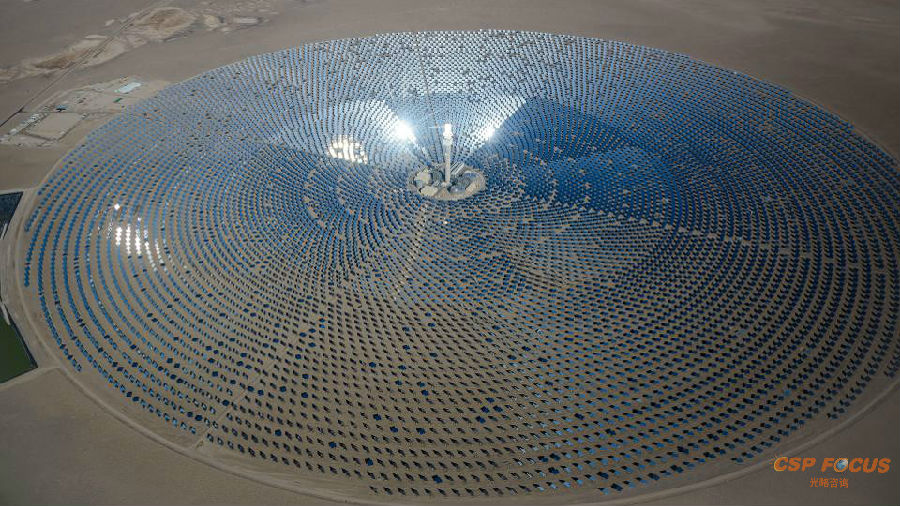Home > Market > Other Regions > Here
Idealab Founder Bill Gross’ Plan To Solve The Mother Of All Quandaries
2020.06.23 From: forbes

Bird's eye view of Heliogen's Lancaster, CA test facility. HELIOGEN
Bill Gates calls it the 75% Problem.
Greenhouse gas (GHG) emissions from power plants only account for 25% of total, and electrical generation is one source of GHG emissions for which cheap renewable sources are well-suited.
If we don’t radically reduce the remaining 75% of emissions, we could carpet Arizona in wall-to-wall photovoltaic (PV) panels and still not do enough to bring down atmospheric CO2 levels.
The trouble is that the remaining three-fourths of emissions are mostly generated through large-scale industrial and agricultural processes that lie at the core of virtually every product we enjoy in our modern lives – steel, glass, concrete, grains, beef, plastics, chemicals…the list goes on and on.
These end products or their essential inputs can only be manufactured by using very high temperatures; with current processes, the only way to generate the heat required is by burning fossil fuels.
This situation leaves us with the mother of all quandaries:
Either we destroy the capacity of the planet to sustain our complex human civilization or we give up the fruits of our complex human civilization to preserve the planet for some schmoes we will never meet.
When faced with this kind of a quandary, the only solution is to think outside the box.
I’ve got it! Why don’t we tie industrial production to a process that can scale really quickly, like Moore’s Law!
In fact, one of the most inventive, entrepreneurial engineers ever to come out of CalTech’s annual crop of incredibly inventive, entrepreneurial engineers – Bill Gross, founder of the first tech incubator, Idealab – has already followed the chain of logic above and come to the same Moore’s Law epiphany. He and the company he founded to operationalize his Eureka moment, Heliogen, is well on the way to implementing a solution that holds enormous potential for mitigating climate change.
If Gross and Heliogen are successful in their ambitious plans, we will all have a chance to continue enjoying the fruits of a modern, industrial life using heat generated solely by renewable resources.
Heliogen’s secret is the application of recent advances in computing power, imaging systems, and artificial intelligence to the field of Concentrated Solar Power (CSP).
A Brief Guide to CSP
Different CSP configurations exist; the type most analogous to Heliogen’s system has the great name of Solar Power Tower.
CSP installations do not absorb solar energy like PV panels – instead, they concentrate the sun’s light at a specific point using mirrors. Solar power tower installations are some of the most beautiful and elegant industrial facilities I can imagine, with a meticulously arranged, dish-shaped array of large mirrors, called “heliostats,” that silently reflect the sun’s light at a focal area on the central tower.

Aerial view of the Crescent Dunes Solar Energy Project, a 110 megawatt plant near Tonopah, Utah. WIKIPEDIA.ORG
Pipes running to the top of the tower and back allow molten salt to flow into an area at the heliostats’ focal points. The concentrated light rays heat the molten salt before moving it into an insulated tank where it can be stored until it needs to be used, for example, to create steam to run a generator.
These CSP installations operate on what engineer’s term an “open-loop control system,” just like your kitchen oven.
Your oven buzzer rings when the time you initially set runs out, whether the oven contains a 14-pound lump of turkey sashimi or if your roast is well on its way to becoming a cubic zirconia. The oven receives no information about the doneness of the dish, so can’t make adjustments to the heat or the cooking time.
Similarly, heliostats in a CSP installation are programmed to move according to precise calculations of where the sun should be in the sky, but do not receive information about how accurately their rays are hitting the tower.
In a world where there were no earthquakes, wind, dust storms, or clouds, an open-loop control system would work just fine. In the world we live in, these kinds of environmental factors mean that heliostats are never positioned exactly right; since they don’t receive feedback from the tower about where their beams are hitting, they can’t compensate for the environmental factors throwing them off.

A view of the central tower at the Ivanpah Solar Power Facility in the Mojave Desert. The tower area ... [+] WIKIPEDIA.ORG
Because the light from the heliostats is not perfectly concentrated, current CSP installations can only generate temperatures up to around 650 degrees Celsius. This is sufficient for some industrial applications, but for the really polluting activities – manufacturing steel, glass, concrete, and hydrogen – the CSP temperature ceiling is about 400-900 degrees lower than what we need.
Heliogen CSP
Gross realized that by turning a CSP installation’s open-loop control system into a closed-loop one, he could concentrate the sun’s rays much more precisely and, in so doing, generate much higher temperatures.
Heliogen CSP arrays take advantage of:
The awesome computing power now available at dirt cheap prices in the form of graphical processing units (GPUs) made by companies like NVIDIA
The ultra-high-resolution imaging systems that are now de rigueur in every smartphone camera in the developed world
Advances in AI that allow computers to tirelessly make tiny, real-time adjustments to a mechanical process
In other words, Gross has designed Heliogen so that its technology can ride the wave of Moore’s Law rather than being stuck on the plodding development path associated with civil engineering projects.
The efficacy of the Heliogen CSP design is evident from photos of the company’s test installation in Lancaster, California.

A view of the solar power tower at Heliogen's Lancaster, California test facility. The area ... [+] HELIOGEN
The Heliogen heliostats are so precisely focused using the closed-loop control system that the sunlight is concentrated in the small circle on the tower seen in the photo above. The total area at which the reflected sunlight is concentrated in a Heliogen system is about the size of a basketball hoop. Compare that to the focal area of a conventional CSP system, which is about the size of a New York City brownstone.
Heliogen’s phenomenally accurate focusing is made possible by cameras mounted on the tower that monitor the angle at which the heliostats are pointed and by a few powerful but off-the-shelf GPUs that use proprietary software to make real-time adjustments to the position of the heliostats.
Gross told me that the system hit 1,000 degrees Celsius immediately after the team flipped the switch on its first test run and that, after a bit of tweaking, the test installation is now capable of hitting 1,500 degrees Celsius – precisely the range that the most polluting industrial applications require.
Potential Impact
While all the articles covering Heliogen I’ve seen so far talk about the potential to carry out cement manufacturing, the thing that excited me when I started researching the company was the potential to split water to manufacture hydrogen.
Cement is heavy and hard to move. Heliogen stores heat energy in stone, another medium that does not immediately bring “portability” to mind. However, hydrogen is the lightest element and is easily transportable – as long as one is careful with it. It can easily be converted into useful, energy dense chemicals as well.
Completely aside from my conversations with Gross, I have been struck by the number of reports that have crossed my desk lately opining about the hydrogen economy of the future. At present, 95% of hydrogen is produced using a process called “steam reformation” which burns copious amounts of fossil fuels. The fact that Heliogen sees a pathway to manufacture essentially unlimited amounts of hydrogen without burning a single fossil fuel molecule is an unalloyed positive for society.
This allows civilization the chance to maintain a high standard of living while getting the Keeling Curve headed in the right direction.
Next Steps for Heliogen
Heliogen’s announcement in late 2019 that it had generated temperatures of 1,000 degrees Celsius using its CSP system garnered a flood of requests from firms around the world. Gross told me that, out of this initial group, he hopes to go live with three major pilot projects within the year. The aggregate revenue potential for Heliogen when each of these pilots are built out totals billions of dollars.
By: Erik Kobayashi-Solomon
Upcoming CSP events:
10th CSP Focus China 2020 (Time TBA, Beijing China)
5th CSP Focus MENA 2020(September 9-10,Dubai, UAE)
More CSP news and reports please visit www.cspfocus.cn
or CSP Focus social media on LinkedIn, Twitter, Facebook.
More from CSP Focus
NextENGIE announces 650 MW of renewable energy offtake contracts with Amazon
Global Concentrating Solar Power Updates丨CSP Focus Monthly October 2019
Brightsource Innovates a Solar-cured Coating for DEWA Tower Concentrated Solar Power
Dewa awards advisory contract for Dubai’s Mohammed bin Rashid Al Maktoum Solar Park
Shanghai Electric analyzes Dubai 700MW concentrated solar power project
SEPCO3 and BAOWU signed the EPC contract of Tibet Zabuye Integrated Energy Supply Project
Leave your thoughts here
Reports(Member Only)
See more+-
CSP Focus Membership Proposals
We are now proposing CSP Focus Membership, hoping to better serve our members to keep pace with the latest updates of ongoing CSP projects worldwide, and to establish and maintain business relations with major shareholders of the projects. CSP Focus offers to Membership exclusive access to:1. Daily/Weekly update and analysis on CSP policies, projects, technologies, market trend and corporate relea
-
The Latest CSP Focus Monthly Update
Join CSP Focus Membership to Get the Latest CSP Focus Monthly Update December Edition.
-
CSP Project Monthly Update 2022 December Edition
CSP Focus is presenting CSP Project (China) Update 2022 December Edition.Detail report is available for CSP Focus Membership.
-
Presentations-CSP Focus China 2021
The Report is for CSP Focus Members only.
Upcoming Events
See more+-
12th CSP Focus China 2022
2022.04.21-22 Beijing
-
11th CSP Focus China 2021
2021.10.28-29 Beijing
-
10th CSP Focus China 2020
2020.10.22-23 Beijing, China
Project Updates
See more+-
Lanzhou Dacheng Dunhuang CSP Project
Asia Pacific-China,Operational,Parabolic Trough
-
Luneng Haixi 50MW Molten Salt Tower CSP Project
Asia Pacific-China,Operational,Power Tower
-
Dubai 950MW NOOR Energy 1 CSP+PV Project
MENA-UAE,Under construction,Power Tower
-
Power China Gonghe 50MW Molten Salt Tower CSP Project
Asia Pacific-China,Operational,Power Tower





